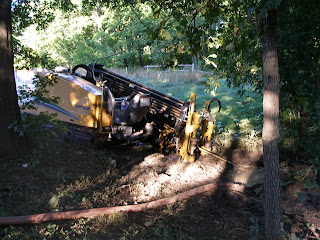Non-Invasive Ground Piercing for Geothermal Heating
 When we were planning our new system we had a perfect area for the 900 feet of pipe we needed to bury eight feet in the ground. It was a flat lightly forested area just 100 feet from the house and had a clear shot across our land. Getting the pipe in the ground without tearing up our soil and woodland was an issue. Jeff, our installer suggested a ground piercing technique he had heard of, usually used for utilities going under existing roads.
When we were planning our new system we had a perfect area for the 900 feet of pipe we needed to bury eight feet in the ground. It was a flat lightly forested area just 100 feet from the house and had a clear shot across our land. Getting the pipe in the ground without tearing up our soil and woodland was an issue. Jeff, our installer suggested a ground piercing technique he had heard of, usually used for utilities going under existing roads.The ground piercing worked great. It involved only a small pit where the five-pair runs of underground piping was connected to the main two heat pump lines to the house and 5 four inch holes where the initial runs popped up in the woods. (This is where the pipe is then pulled into the ground to depth.)

The piercing controls exact placement of the pipe. A radio transceiver guides and steers the piercing tip underground to within inches of the target. We had the house run com up through the basement floor right on target. We had an option of running the pipes much deeper than trenching would allow and with the articulated tip the piercing was guided around trees and followed the topography. I flagged the runs topside with stakes so we will have a way to put them on our basemap later. The pipe has a 100 year life and twenty year warranty.
BTW, this new heatpump system replaces a 6 year old oil furnace the previous owner installed.
It was a wallet killer last winter and now sits in the barn with three 55 gallon drums of heating fuel waiting for a new life. Fat chance.
 At left are the manifolds that connect the underground runs to the main lines. They are about ten feet down in the only pit we had to dig.
At left are the manifolds that connect the underground runs to the main lines. They are about ten feet down in the only pit we had to dig. The pipes at right connect to the heatpump in the house. This is where the piercing ends. No trenches, no soil damage, very neat and in at least a quarter the time. We minimized the soil disruption to a small area that will soon be a garden. I will show our solar-ready ground source heat pump system in a later blog.
The pipes at right connect to the heatpump in the house. This is where the piercing ends. No trenches, no soil damage, very neat and in at least a quarter the time. We minimized the soil disruption to a small area that will soon be a garden. I will show our solar-ready ground source heat pump system in a later blog.

Comments
Many many thanks for all your posts. Very educational. I hope to run into again sometime at a permaculture workshare to find out more about your heat pump experience. As a designer that reads about this stuff but doesn't have installation experience this information is helpful. I am curious whether you looking into a true geothermal system. I suppose you have and it was a cost issue (maybe a land disruption issue as well.)
The ground piercing you are describing here sounds like a remote controlled auger. Is this a correct characterization? Can this auger be run both horizontally and vertically?
I am not sure of what you mean by true geothermal, no hot springs or volcanic action here. This is a ground source heat pump and yes it can go very deep except it must come up somewhere to pull back the pipe to the source pump. I have heard the "auger" has gone down as far as 55 feet and hundreds of feet laterally. It has a 10 degree limitation on turn radius.
As far as vertical ground source. 200 foot wells. One per ton of output. We would have needed 5 wells if we had no land to lay piping.
The system is operational at this point. As it would happen, of course, the weather is beautiful and we have not had a need for it yet. We did run the house up to 80 degrees for a test and found a few things to adjust in our pipe insulation. Like more of it and and duct work that needs wrapping. The heat exchanger goes to forced air not radiant, so we have that interface compromise to optimize as we go.
I am already eying adaptations for a solar interface and waste water heat recovery. So many possibilities. Dan
I had to back up and refigure a distinction I thought I had clear in my head. Yes a true geothermal system would have to dig down roughly 6 miles to take advantage of the heat generated by the molten layer below the earth’s crust. I had mistakenly associated this with a vertical pipe run configuration for ground source heat pumps and also thought there was a gradient of an increasing heat and the further you went down the better.
I recall from discussions when I worked at a residential architecture firm that several clients who had wanted to install GSHPs would have to install the pipes vertically because of the limitations of their city lot and this was cost prohibitive (and/or it may have been that case that bedrock was close to the surface and getting sufficient surface area with the ground pipes entailed drilling through rock which was cost prohibitive). I guess now I am assuming a lateral run of pipes is less expensive which I don’t know.
Mark-
I have learned you have to be careful the operators know what you want. You have to stake out the exact area and dictate the depth you want. They mark the ground to keep track, but monitoring and mapping the placement is a good idea. I have stakes where the pipe is but not the exact depth. That would be nice to know. The installer can tell you both as the piercing is done. It took about an hour for each run. Set-up time is considerable. One pit is dug to connect the house lines and manifold to the lateral runs.
This is a great way to go. Oversizing your underground array should be considered. I think the calculations for materials are minimums. Run deep and go long depending on your soil.
.
Call Logical Heating in Rogers MN if you are interested in a system. They are great.